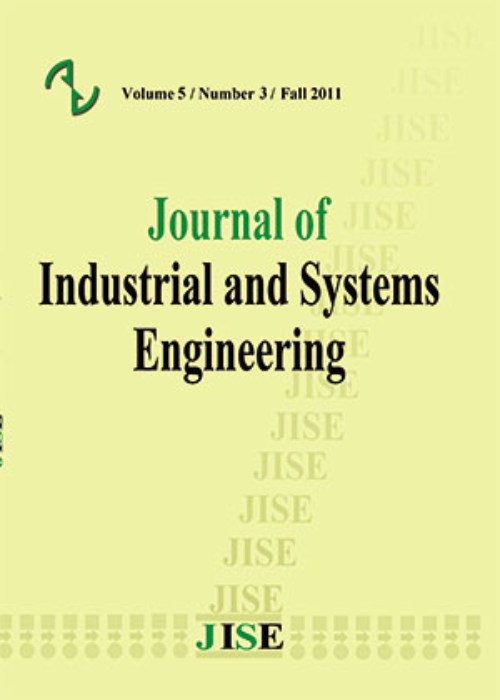فهرست مطالب
Journal of Industrial and Systems Engineering
Volume:3 Issue: 4, Winter 2010
- تاریخ انتشار: 1388/10/11
- تعداد عناوین: 5
-
-
Page 227Drivers in urban neighborhoods who cruise streets, seeking inexpensive on-street parking createa significant fraction of measured traffic congestion. The solution to this problem is to reducethe total traffic volume including cruising traffic by implementing a congestion pricing scheme:the imposition of a usage fee on a limited-capacity resource during times of high demand. Wereview the history of two alternatives for implementing congestion pricing scheme: roadpricing (RP), which involves cordoning off a section of the center city and imposing a fee onall vehicles that enter it; and parking pricing (PP), which increases the costs of on-street andperhaps off-street parking. PP is needed in many environments where a significant fraction ofdrivers are simply cruising, looking for inexpensive on-street parking. In this paper, we proposea simple method to estimate the number of cruising drivers and the optimal parking price. Oursurvey in Boston shows that the number of cruising vehicles reaches 10-20% of the total number of parking spaces during peak hours and the required congestion charge (CC) for onstreetparking is at least about $1/ hour.
-
Page 243In this paper we consider an imperfect production system which produces good and defective items and assume that defective items can be reworked. Due to the nature of rework process we do not restrict the rework rate to be equal to normal production rate or constant and assume that it is a random variable with an arbitrary distribution function. We also assume as it is true in most real world situation that the unit rework processing cost need not to be equal to unit normal processing cost. We consider the case in which during a specified period of time consisting of several cycles the rework process takes place only in itslast cycle. For practical reasons such as the ease of production scheduling and resource planning we require that the length of the last cycle must have the same length as the other cycles of this period. For this purpose we assume in the last cycle of this period first the normal production starts after which the rework of all defective units produced in the period begins. After the end of the last cycle of the period the whole process will start all over again. Further we assume that, for reduction of set up cost for rework per unit time, the total number of setups for rework must be as small as possible. For this system we derive the expected total cost function consisting of inventory holding, waiting time of defectives for rework, setup, and processing costs per unit time. Then we obtain the economic batch quantity which minimizes this expected cost.
-
Page 257Neural networks were used to estimate the cost of jet engine components, specifically shafts and cases. The neural network process was compared with results produced by the current conventional cost estimation software and linear regression methods. Due to the complex nature of the parts and the limited amount of information available, data expansion techniques such as doubling-data and data-creation were implemented. Sensitivity analysis was used to gain an understanding of the underlying functions used by the neural network when generating the cost estimate. Even with limited data, the neural network is able produced a superior cost estimate in a fraction of the time required by the current cost estimation process. When compared to linear regression, the neural networks produces a 30% higher R value for shafts and 90% higher R value for cases. Compared to the current cost estimation method, the neural network produces acost estimate with a 4.7% higher R value for shafts and a 5% higher R value for cases. This significant improvement over linear regression can be attributed to the neural network ability to handle complex data sets with many inputs and few data points.
-
Page 275Due to the continuously increasing container trade, many terminals are presently operating at or close to capacity. An efficient terminal is one that facilitates the quick transshipment of containers to and from ships. In this sake, this paper addresses the ship assignments problem at a maritime container terminal, where ships are normally assigned to specific quay cranes until the work is finished. The paper’s target is to develop a new Continues Berth Allocation Problem (CBAP) in the form of a mixed integer nonlinear programming to achieve the best service time in a container terminal. For illustrating the accuracy of Proposed model (PM), Imai et. al. ''s model (IM) (TRANSPORT RES B, 39 (2005) 199–221) was applied and a wide variety of computational test examples were conducted. The results of demonstrated that the presented BAPC reduces the number of nonlinear variables (constraints) and generates substantial savings in the CPU time.
-
Page 291This study explores a semi-supervised classification approach using random forest as a baseclassifier to classify the low-back disorders (LBDs) risk associated with the industrial jobs.Semi-supervised classification approach uses unlabeled data together with the small number of labelled data to create a better classifier. The results obtained by the roposed approach are compared with those obtained by a backpropagation neural network. omparison indicates an improved performance by the semi-supervised approach over the random forest classifier as well as neural network approach. Highest classification accuracy of 78.20% was achieved by the used semi-supervised approach with random forest as base classifier in comparison to an accuracy of 72.4% and 74.7% obtained by random forest and back propagation neural network approaches respectively. Thus results suggest that the proposed approach can successfully classify jobs into the low and high risk categories of low-back disorders based on lifting task characteristics.


